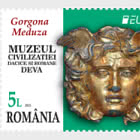Joint stamp issue Romania-Germany: The fortified Church of Biertan – Monument from UNESCO World Heritage
Halfway between Medias and Sighisoara, in Transylvania Plateau, you can find one of the earliest Saxon settlements from this part of the country. Documentarily attested for the first time in 1283, the village, like any other Saxon settlement, had a central square around which there were rows of houses.
In the contents of a “Papal Indulgence” given in 1402, the name of a church called Saint Mary was registered. Today, on its place, in the middle of the village, on a hill, there lays the imposing Biertan fortress-church, built between the 15th and the 16th centuries (1490-1524). The architectural elements of the edifice belong to the late Gothic, the Renaissance and Baroque styles as well. The interior paintings of the halidom were made between 1515 and 1524.
The church is not only the last edifice of this type (hall-church) built in Transylvania, but also the best preserved one. For almost 300 years, Biertan was the headquarters of the Lutheran Protestant Episcopate of Transylvania, between 1572 and 1867.
Following the frequent attacks of the Ottomans and Tatars, the Saxons fortified their church with three walls and eight towers, out of which we mention The Catholic Tower, The Wooden Bell Tower, The Bastion Prison Tower or The Clock Tower. The Tower’s horologe bears the Latin inscription: “Jesus in aeternis rex judeorum”(Jesus, forever the King of the Jews - 1508).
An important piece of the church is the bronze disk-shaped “donarium”, discovered in 1775, a few miles away from Biertan. It is a fragment of a 4th century A.D. chandelier and its Latin inscription “ego zenovius votum posui” (I, Zenovius, offered this gift) proves the prevalence of the Christianity among the Dacian-Roman population.
The church pulpit carved in one single piece of stone is a genuine work of art, built by the master Ulrich from Brasov in 1523. The pews are made of lime wood by Johannes Reichmut from Sighisoara between 1514 and 1523. The door of the vestry, also made by J. Reichmut in 1515, is unique in Europe, both for its exterior plate, whose ornaments are special and for its locking system with 19 locks in 19 spots. To open them, one needs a key and a handle. In 1910, the door with its lock got a prize at the World Exhibition in Paris.
The church organ, made in 1869 by the master Karl Hessefrom Viena, has 1,290 pipes. The altar is one of the largest in Transylvania and it was achieved by masters from Nürnberg and Vienna between 1483 and 1513. It contains 28 paintings representing biblical scenes. A valuable inheritance is represented by the three bells: the large bell (15th century), the medium bell (14th century) and the small bell on which the year 1738 is engraved.
By its historical and esthetic value, by original architecture preservation and its contribution to the village’s harmony, the fortified church of Biertan, part of UNESCO World Heritage since the year 1993, was chosen as a common element for Romania-Germany joint stamp issue that Romfilatelia introduces into circulation.
It should be mentioned that the unique design of the stamps of the two countries is made by Razvan Popescu, the winner of the philatelic contest that took place in 2010 in Berlin and was organized by the Ministry of Finance of the Federal Republic of Germany and Romfilatelia.
Philatelic document – issued into a limited run printing of 240 copies, equipped with the postage stamps of the joint issue of Romania and Germany, numbered and cancelled with the “first day” postmark of the corresponding country.
Engraving – achieved into a limited run printing of 350 pieces by the young artist Livia Raduta-Penda, the daughter of the regretted engraver artist Octavian Ion Penda. The engraving reproduces the postage stamp of the issue illustrating the Fortified Church of Biertan, serving also as a displaying support of the postage stamp. The products are numbered in red from 001 to 350, bear the author’s holograph signature and have the Romfilatelia embossed logo imprinted.
Romania - Recommended stamp issues
WOPA+ recommended stamp issues
| Avatar - Fire and Ash |
| Issued: 03.12.2025 |
| ›New Zealand |
| 50th Anniversary of the Founding of the 24th November Bar Scout |
| Issued: 24.11.2025 |
| ›Montenegro |
| Krisjanis Valdemars |
| Issued: 02.12.2025 |
| ›Latvia |
| Sign Language - Good |
| Issued: 02.12.2025 |
| ›Bosnia and Herzegovina - Republic of Srpska |
| In Memory of the Fallen and Murdered on October 7, 2023 |
| Issued: 08.10.2025 |
| ›Israel |
| Annual Collection Folder (New York) |
| Issued: 05.12.2025 |
| ›United Nations |
| Year Set |
| Issued: 24.11.2025 |
| ›Isle of Man |
| Shipping in the 17th and 18th Centuries - Peat Shipping |
| Issued: 05.12.2025 |
| ›Netherlands |









































